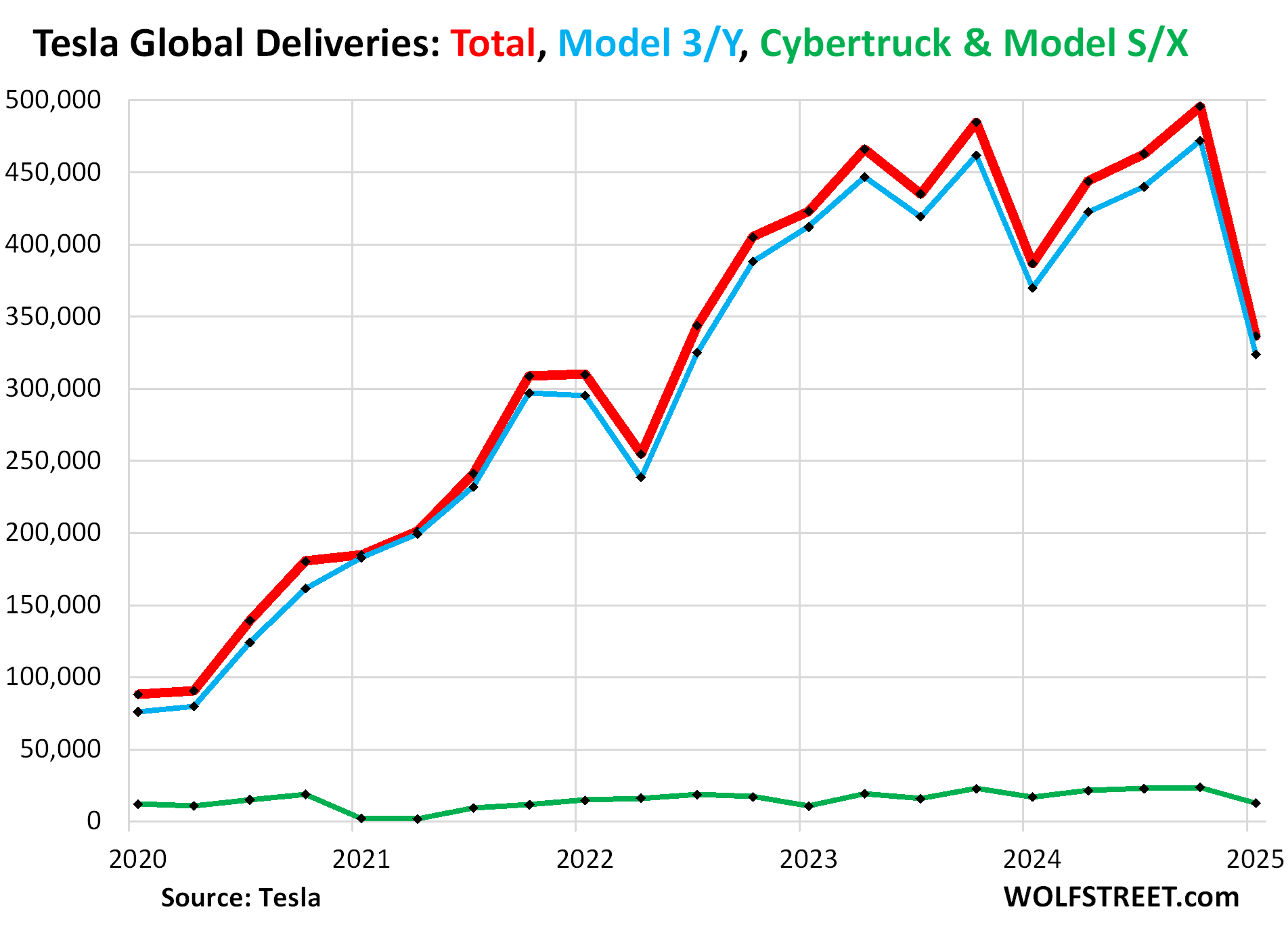 [[{“value”:”
[[{“value”:”
GM’s Q1 sales soar, with EV sales +94%, Hyundai-Kia and Honda sales soar, Toyota’s nearly flat, Ford’s dip, Stellantis still in death spiral.
By Wolf Richter for WOLF STREET.
Sales of new vehicles jumped by 13.3% year-over-year in March, to a seasonally adjusted annual rate of 17.8 million, the highest March sales since 2021, and finally back in the range before the pandemic. This should portend well for retail sales and consumer spending in March.
March marked the sixth month in a row of year-over-year growth:
- March: +13.3%
- February: +2.2%
- January: +3.1%
- December: +6.0%
- November: +7.8%
- October: +5.0%.

In Q1, not seasonally adjusted, new vehicle sales rose by 4.8% year-over-year, to 3.91 million vehicles, the best Q1 since 2019, following the 4.5% increase in Q4.
March had 26 “selling days,” one fewer than March 2024. Seasonal adjustments account for the difference in selling days. Not seasonally adjusted and not annual rate, new vehicle sales jumped by 10.7% in March year-over-year to 1.585 million vehicles, the best March since 2021.
The first quarter is always low in new vehicle sales with January and February being the worst months of the year, and March being the beginning of the spring selling season (“tax refund season”). So Q1 2025 was almost back at prepandemic levels, but not quite yet.
After the massive price increases in 2021-2022, new vehicle sales have been handicapped by affordability issues and consumer frustration with high prices. With inventories then ballooning, automakers threw price cuts and incentives at consumers to roll back those price increases and stimulate sales.
March might have been helped by a stronger-than-a-year-ago tax-refunds flow and possible frontrunning by consumers of any price increases they fear tariffs might cause.
Ironically, this strong demand is causing automakers to roll back their incentives and price cuts that low demand and high inventories had brought about.
Average incentives (price cuts from MSRP) per vehicle sold rose year-over-year to $3,059, or 6.1% of MSRP (in March 2024, incentive spending amounted to 5.8% of MSRP), according to J.D. Power estimates.
Incentive spending is how the legacy automakers adjust prices. The MSRP is set for the entire model year, and incentive spending brings it down low enough to move the inventory. High and growing inventories cause automakers to increase incentive spending.
But this strong demand caused automakers to trim back their incentive spending a tad in March from where it was in February.
Q1 sales growth was not equally spread.
Among the big automakers, some booked strong year-over-year sales gains in Q1 (GM for example), while others experienced sales declines (Ford, for example), and sales at Stellantis continued to plunge.
#1 General Motors, Q1 sales: +16.7% year-over-year, all brands combined, to 693,363 vehicles.
EV Sales soared by 94% to 31,887 vehicles. At Chevrolet, EV sales, led by the Equinox EV and the Blazer EV, soared 119%.
EVs do not include hybrids (they’re ICE vehicles). GM has come out with a new lineup of EV models, including pickup trucks. Some models became available in 2023 and 2024, others are becoming available in 2025. The old Bolt and Bolt EUV were discontinued at the end of 2023.
#2 Toyota, Q1 sales: +0.9% year-over-year, to 570,269 vehicles, Toyota and Lexus brands combined.
Toyota has made a U-Turn on EVs, after wasting years pooh-poohing them, and is now spending huge amounts of money in a rush to develop them. It has only one EV on the market, the bZ4X which it jointly developed with Subaru, and whose sales soared by 195% year-over-year, to 5,610 units, already outselling several models, including nearly all Lexus models (except for the Lexus ES).
#3 Ford, Q1 sales: -1.3% year-over-year, to 501,291 vehicles, Ford and Lincoln brands combined.
EV sales rose by 11.5% to 20,223 vehicles: Mustang Mach-E sales of 11,607 (+21.0%), F-150 Lightning of 7,187 (-7.2%), plus some electric van sales.
#4 Hyundai-Kia Q1 sales: +10.4% year-over-year, to 402,404 vehicles, a record first quarter, with both Hyundai and Kia reporting 10%-plus sales gains. Both started manufacturing their EVs in the US.
#5 Honda Q1 sales: +15.8% year-over-year, to 351,577 vehicles, Honda and Accura brands combined.
Honda still doesn’t make EVs, but it working on them. It is selling one EV, the Prologue, which it buys from Chevrolet (Blazer EV), though the body panels are a little different from the Blazer EV.
#6 Stellantis Q1 sales: -12% year-over-year, all brands combined, to 293,225. The death spiral continues.
- Ram pickup truck sales: -2% to 93,368
- Chrysler sales: +1% from collapsed levels, to just 35,069.
- Jeep sales: -10% to 140,583
- Dodge sales: -49% to 21,731.
#7 Nissan Q1 sales: +5.7% year-over-year, to 267,085 vehicles, Nissan and Infiniti combined.
Tesla doesn’t disclose US sales. It only discloses global sales. For Q1, Tesla’s global sales plunged by 13% year-over-year, lowest since Q2 2022, as Elon Musk is crushing one of the most successful consumer brands.

Enjoy reading WOLF STREET and want to support it? You can donate. I appreciate it immensely. Click on the mug to find out how:
![]()
The post Our Drunken Sailors Are Back: New Vehicle Sales Surge in March, after Rising in January & February, Best Q1 since 2019 appeared first on Energy News Beat.
“}]]

